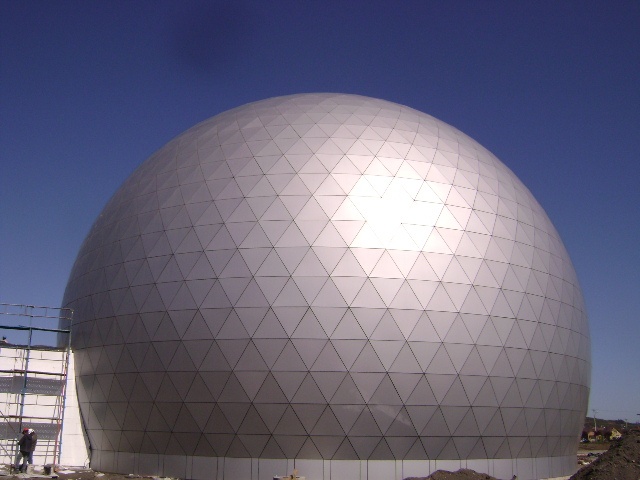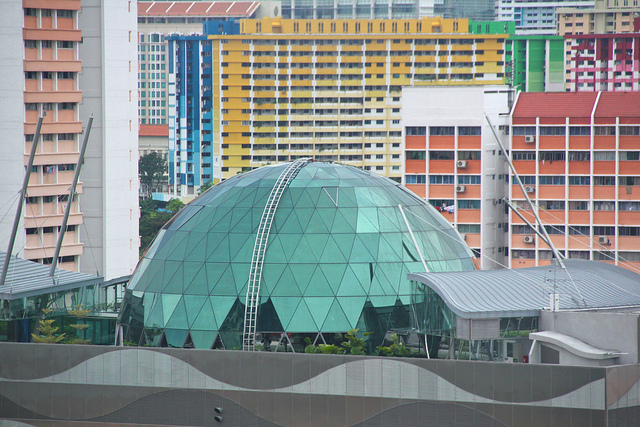Domes
Domes are surfaces that curve in two directions. The most common domes spring from a circular base and for that we call them "circular domes" at Geometrica, even if their cross-section is not circular. So the term "circular dome" differentiates domes on a circular base from Freedomes® that spring from bases of other shapes.
While their base is circular, these domes can still have quite a variety of shapes and structure. Three main geometric parameters that define a circular dome are meridian, pattern and layers.
Meridian
Circular domes are surfaces of revolution. These surfaces are generated by rotating a meridian curve about a vertical axis. The meridian curve is then one half of the curve at a vertical section through the center of the dome.
Meridian curve example
Meridian curves are similar to the cross-sectional curves of vaults - they may be optimized for certain loads, or shaped to "hug" any clearance line desired. For example, if there are large apex forces, an acute geometry provides a positive slope near the apex load to resist the load, or in storage applications with automated stacker-reclaimer equipment, the meridian may start nearly vertical, and then quickly turn into a more gentle slope as in this 133m sulfur storage dome.
Pattern
Although square-grid and radial geometries (or combinations of these) are sometimes used in domes, the in-surface geometry of the dome should really be fully triangulated in order to develop the full benefits of shell-action. A dome with square patterns on the surface will generally result in a heavier framework. Triangulated patterns, known generally as “geodesic domes", are more efficient. Some in-surface layouts of nodes have names, such as “Lamella”, “Kiewitt”, and Geometrica's own Lace™, Sol™ and Saturn™ geometries.
Lace™: This geometry is generated from a uniform triangular grid trimmed to a dodecagon shape, then stretched to form a circle, and finally wrapped onto the surface of revolution. The resulting geometry is structurally efficient. It also maintains nearly-equilateral triangles and has a uniform base. Some of the largest domes in the world, such as the 133 m Ruwais dome in the UAE, the 142m San Cristobal dome in Bolivia, and the 122m JEA domes in Florida are built with the Lace geometry, or with a lamella-lace combination geometry.
Lamella: Lamella domes are generated with concentric rings, where each subsequent ring is rotated by a half module. This reduces the length of the ring tubes as the geometry proceeds towards the apex. When the tubes of the rings become too small (usually half the length of the first), they "consolidate" to the next ring, joining the two divisions into one. The separation between rings in Lamella domes can be varied so they are equilateral triangles forming each ring. Because the tubes of each ring are equal, the manufacturing time is fast and assembly is easy. Lamella domes are beautiful and a favorite for architectural applications. Domes such as the Cancun Hyatt and the Mustafa Centre use Lamella geometry.
Kiewitt: Kiewitt domes are also generated with concentric rings. Generation starts from the base with a specific number of divisions making the modules of a reasonable length. Then subsequent rings reduce the number of divisions by the number of segments in the dome. Generally the number of segments is set between 5 and 8. As with Lamella domes, the horizontal Kiewitt rings provide an easy check during construction, but the pattern results in many more different parts. Kiewitt domes include the 112m Marchwood dome in the UK.
Icosahedral: A icosahedral geometry projects a subdivision of an icosahedron onto the surface of a sphere. Popularized by Buckminster Fuller in the 1950s, it is still a very popular geometry. It is recognizable by the pentagons that occur at the vertices of the icosahedron used to generate the dome. The Children’s museum in Aguascalientes, Mexico uses this geometry for its Omnimax theater.
Schwedler: This geometry is generated by laying out principal members along meridians and rings, and then introducing diagonals to triangulate the rectangular modules. It is easy to generate, but not very efficient. Diagonal members are substantially longer than ring or meridian bars, and must therefore be more robust to resist buckling loads. It finds some application in glass-clad domes, as trapezoidal glazing is less expensive than triangular. For other uses this geometry will result in structures 20 to 30% heavier than the alternative geometries.
Sol™: Sunflowers, seashells, galaxies and hurricanes exhibit a beautiful pattern of intersecting spirals, with very uniform distances between nodes. It is preferred for applications that require a natural or organic look, and had been originally specified by architects Norman Foster and Fernando Romero for their winning design of the Mexico City Airport competition.
Layers
Depending on the number of layers of chord elements, domes may be single-layer, double-layer-vierendeel, double-layer-truss, or ribbed.
Single layer geometries are used for moderate spans, for architectural applications, and for long span applications when used with oval or rectangular tubes.
Vierendeel geometries can be used for most circular domes and freedomes. These are double-layer frames with parallel nodes in each layer connected with post members perpendicular to the dome's surface. The second layer increases the bending strength and the buckling resistance without introducing unnecessary web elements.
Double layer truss geometries are used whenever there are large or concentrated loads, column supports, or for extremely long spans.
Ribbed geometries are also used in domes. They are easy to install because most of the assembly work may be done on the ground and lifted into place.
Both the double layer truss and the ribbed geometries may benefit from increased chord density.
The Marchwood dome is an example of a dome where various geometries were combined. The ribbed and single-layer geometries are used in the bottom rings of the dome, when a double layer geometry was used in its main areas.
How can all of this come together in your project? For more information about our solutions, please fill our inquiry form.

















